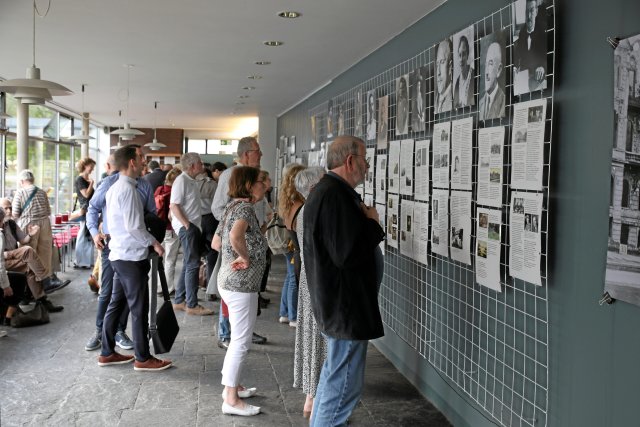The exhibition was well attended when it opened – interest in the local history of the Hansaviertel is obviously high.
Photo: gleis69.de
Where the house number 33 once stood on Brückenallee in Berlin-Tiergarten is now neither a street nor a building. On November 22, 1943, the apartment building that was there was bombed; In the 1950s, the course of the old Hansaviertel was largely changed as part of the International Building Exhibition in 1957.
But the memory of the house and its residents is not lost. Not least thanks to the Moabit Verein Gleis 69, which reconstructed life at Brückenallee 33 at the beginning of the last century for an exhibition. The association was founded in 2018 with the aim of saving the ramp on track 69 of the former Moabit freight station from decay and expanding the adjacent memorial site. Between 1942 and 1944, between 27,000 and 32,000 people, mostly Jews, were deported from this place to the extermination camps in Eastern Europe. Reason enough for a large and protected memorial site, one would think – but the tough fight for the ramp and against the Berlin authorities continues, as documented on the association’s website. Meanwhile, Gleis 69 is also dedicated to numerous other projects, for example providing educational work at schools or curating small exhibitions about (former) Jewish life in Moabit and Tiergarten.
The exhibition “The House Brückenallee 33. A German Kaleidoscope” can be seen in the foyer of the Hansa Library until Friday. The impetus was research for an earlier show on Jewish artists in Berlin-Tiergarten – among them the graphic artist Hermann Struck, who lived and worked at Brückenallee 33. Struck, like other residents of the house, appears in notes written by his neighbor and friend Ernst Freudenheim, who remembered life in Berlin while in exile in the United States. Struck combined contradictions: he was an Orthodox Jew and Zionist, as well as a German patriot. Like Struck, who portrayed Sigmund Freud and Theodor Herzl, among others, and emigrated to Palestine in 1923, the Levy/Levy-Rathenau couple are also presented in the exhibition using text and photographs. Max Levy, an engineer, developed, among other things, the “Tornado” fan model, which is now a popular collector’s item. His wife Josephine, a relative of Reich Foreign Minister Walther Rathenau, who was murdered in 1922, was a committed women’s rights activist. The couple was part of Berlin’s liberal Jewish bourgeoisie; both died before 1933.
Non-Jewish Germans also lived at Brückenallee 33 – some of them who played a role in the Nazis’ rise to power. One of them was Robert von Keyserlingk-Cammerau. He came from an East Prussian noble family and was a lecturer and privy councilor in the Prussian Ministry of Agriculture during the short time in which he lived in Brückenallee (1907–1908). In 1932 he signed a petition addressed to Reich President Hindenburg by bankers, large industrialists and large landowners, demanding Hitler’s chancellorship. After 1933 he gradually distanced himself from the Nazi regime.
Using numerous, detailed portraits, the exhibition brings to mind how, in the time before fascism, Jewish and non-Jewish people, sometimes with very different ideological attitudes, lived next door to each other in the upper echelons of society. The reconstruction of many lives was certainly only possible because it was an upscale, representative residential area. Anyone who lived at Brückenallee 33 was “someone,” no matter what religious community or ethnic group he or she belonged to – and thus left their mark. Many held positions in politics and were successful as entrepreneurs or artists.
Despite their mostly privileged social position, not all Jewish residents were able to save themselves from Nazi terror. Freudenheim’s first wife and his daughter, for example, were unable to emigrate from France, where they had initially fled, to the USA or Palestine. In 1942 they were deported from Drancy to Auschwitz and murdered there. The exhibition in the Hansa Library helps to protect their stories from being forgotten.
“The House Brückenallee 33. A German Kaleidoscope”, until May 31st, Hansabibliothek, Berlin
Subscribe to the “nd”

Being left is complicated.
We keep track!
With our digital promotional subscription you can read all issues of »nd« digitally (nd.App or nd.Epaper) for little money at home or on the go.
Subscribe now!
judi bola online link sbobet sbobet sbobet
